One obstacle to motorcycles being everyday transportation is the fact that protective riding apparel tends to make you look like a roadracer or some kind of futuristic astronaut. If you’re just riding a few miles to work or the grocery store, after you stow your helmet, you want to look like anyone else who just stepped out of a car or off the bus.
That’s why several apparel providers have lines they call “scooter” or “urban.” These garments look like regular street clothing, but have motorcycling-specific features, like impact armor and abrasion resistance, as well as wind and waterproofing. Some brands do it well, others make you conspicuously unstylish.
Corazzo is a brand that does it well. Based in Portland, Oregon, the company has been selling stylish, well-made gear to the scooter and urban-motorcycling set since 2004, offering jackets, gloves, accessories and lifestyle clothing for men and women riders. I was planning a trip to Chicago in March (not my idea) to cover a new scooter’s release, so I needed something that was light and compact (so I wouldn’t have to check a bag), but would still offer protection from the elements and possible pavement surfing.
Corazzo’s Allen Drysdale offered me not just a jacket and gloves, but a whole cold-weather urban-riding system: a Tempeste jacket, a battery-operated heated vest (imaginatively dubbed the “Heated Vest”) and an “Underhoody.” I didn’t expect to like this stuff as much as I do, but I do, and here’s why.
The $289 Tempeste is a textile jacket styled roughly like a military-surplus field jacket. Its shell is made from 600-Denier nylon (“Denier” is a measure of thread weight, not density of the woven fabric, and 600-Denier nylon is not the same thing as 600-Denier Cordura) with Corazzo’s proprietary “Corazzo Storm Shield” waterproof membrane. Light, flexible, CE-approved Sas-Tec armor is standard, installed in Velcro-secured pockets at the shoulders, elbows and back. There’s a zip-out vest liner (that you can wear as a stand-alone garment) and zippered chest pockets that double as vents for hot weather as well as a pair of cargo pockets on the front of the jacket. The collar is kind of a mock turtleneck thing and the cuffs secure with wide Velco tabs. 3M Scotchlite tape adds visibility on the back, cuffs and front. Drysdale told me he’s crashed in this jacket and it held up well, and I believe him—the quality of the material and the stiching seem good (there’s a one-year warranty on it, too) at least as good (and in some cases, much better) than other non-Cordura textile gear I’ve tested.
I really like this jacket. It’s lightweight and has a roomy, comfortable fit, on or off a motorcycle or scooter. The sizing is closer to European sizing than U.S. sizing, so order a size up if you like a more relaxed fit. The armor molds to your body, is light and installs and comes out quickly and easily. The zipper-and-snap closure offers decent (but not perfect) wind protection. The waterproofing is good: it kept my top half dry in a torrential early downpour. The front vents will let a little moisture through, so keep your valuables out of the pockets in the rain. Pull out the armor—it only takes a minute—and it’s a nice-looking, warm and practical jacket for slightly chilly days. There are no hand-warmer pockets, but the sides of the 3/4-length jacket unzip so you can slip your mitts into your pants pockets instead.
Aside from the damp pockets and lack of hand warmers, my main nit was warmth. Chicago in March offers freezing temperatures—no weather for scootering, but sometimes my job is uncomfortable, somehow requiring riding a small scooter on Lakeshore Drive 15 miles to the Science and Industry Museum and then riding back because the stupid U-505 exhibit is sold out. All alone, the not-quite-windproof nylon and thin fleece of the Tempeste would have left me shivering (or worse!), but luckily Allan sent me the $299 Heated Vest as well. It’s a high-collar design with pockets and stretch panels on the side for a snug fit (again, order a size large if you want roomy). Flexible Symtec heating elements—two in the front, one in the back—provide broad, even warmth. You can power it two ways—with the big 4400 milliamp-hour battery or by plugging into your vehicle’s 12-volt system with a standard coaxial plug with an optional connector. A five-stage controller uses LED indicators to show you how much heat you’re getting.
I liked the vest’s fit, but I especially liked how it made riding in temperatures only slightly above freezing possible. With the battery attached, I got around five hours of warmth, alternating between the highest and second-highest settings. Corazzo claims up to seven hours at the lowest setting. Obviously, using your vehicle’s power is better than a battery, but it’s nice to not overtax your charging system—some older rides can’t supply the current—or be able to have the warmth off the bike, so you can roam about the rally or campsite and say things like, “sure is cold, isn’t it?”
The vest is pricey—you can get battery-operated vests for half the cost—but it’s a quality product. The battery is much bigger and offers a lot more life than some competing vests, and it offers more heat elements than some competitors. It’s also a very nicely styled and made item. You get what you pay for.
Corazzo’s ensemble was topped off with the $69 Underhoody. It’s made from a tight-fitting Lycra-poly blend to form a perfect-fitting base layer. The balaclava-style hood and thumb holes in the sleeves make it ideal for motorcycle use—the thumb holes keep it in place when you put a layer on over it and the hood gives you extra warmth under a helmet without affecting fit or restricting vision. Having a moisture-wicking layer next to your body is key to holding dry, warm air next to your skin, and the Underhoody is a great way to do it.
Corazzo’s lineup is extensive, if not lavish. There are women-specific items, as well as gloves and other accessories. A women’s jacket, the Avventura, can incorporate the Heated Vest as a liner, as will an upcoming men’s jacket. It’s a small company, and you won’t see its gear in every shop, but it’s functional, stylish and a great choice for urban riders.
See Corazzo’s line of apparel and other items here.
Gabe Ets-Hokin is the Editor of City Bike Magazine, and a frequent freelance contributor to MotorcycleDaily.com.
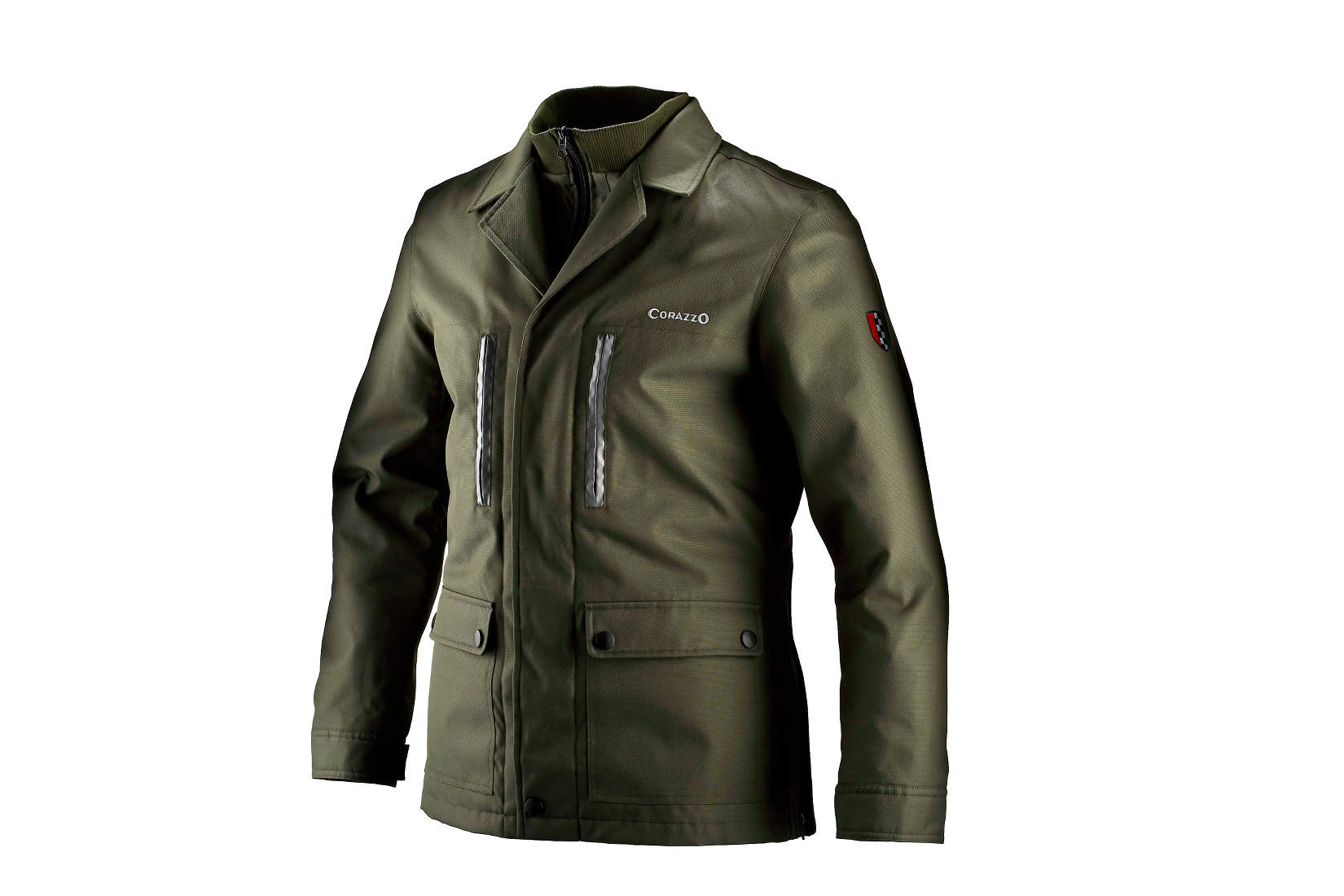
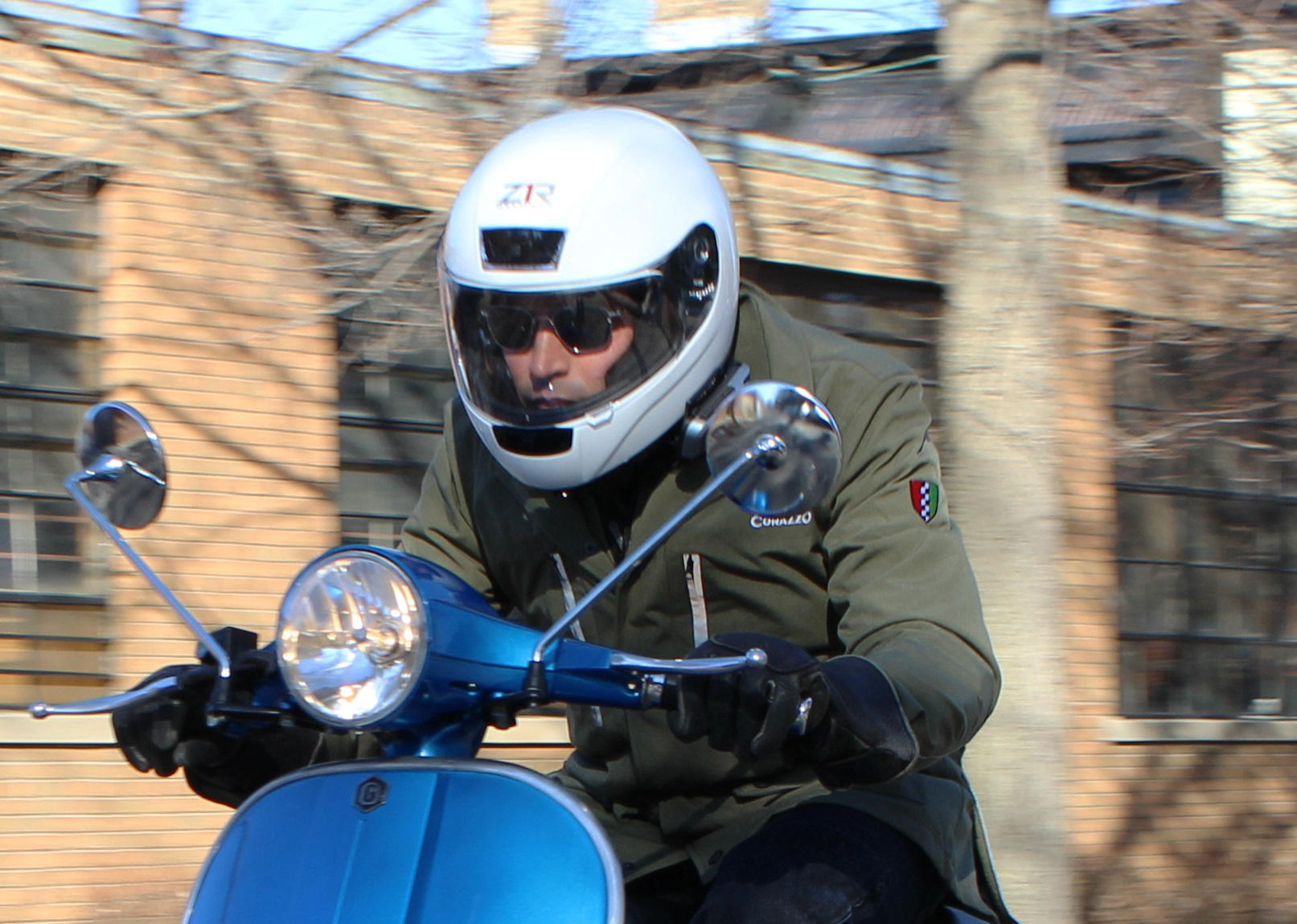
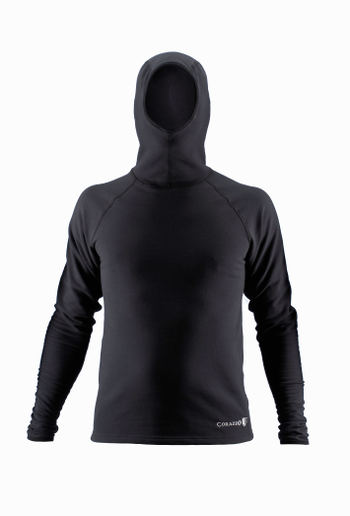
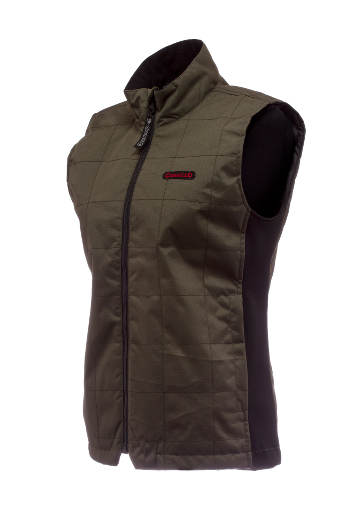
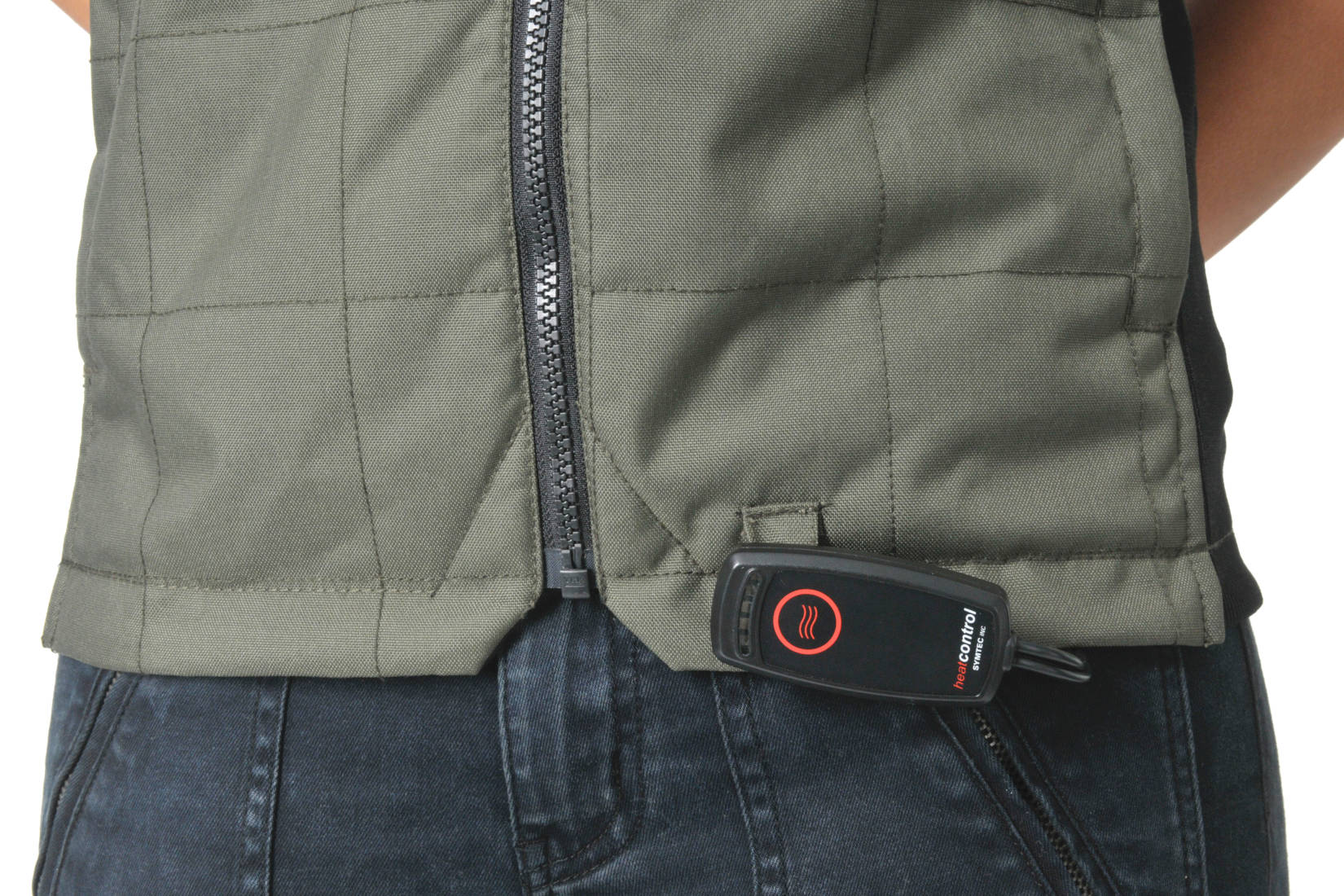






Looks good for the urban scene, but not the freeway. Would like to see a lighter color option for more visibility, though. Just a note on on the fabric discussion – you’d be surprised how many ‘nylon’ jackets are polyester. Check the label. And a crash story just for fun. My buddy got hit by flying tire tread, went down on the freeway at 70mph, slid on his back in a years-old Dainese Cordura jacket, came home without a scratch or melt wound.
https://encrypted-tbn2.gstatic.com/images?q=tbn:ANd9GcRkdCP2EbRWUAxfAZ7HlQrE2Giwdr1Q4qFRaeVBkhAqMB0BFabWbQ
Man thats says Wehrmacht like nothin I know I like it!!!!
Too bad you missed the U-505. That is the single coolest museum exhibit in the world IMO. Awesome!!!!!!! I remember the boat the way it used to be displayed on the lawn, all rusted and looking like caca. But now buried in the “sub pen” it amazing to behold.
Gabe, that photo of you on the Genuine scooter looks like it was taken in front of Genuine/Scooterworks on Damen avenue in Chicago. How did you like the scooter?
Was the Stella a 4 or 2 stroke? Looks like a 4 speed twist shift. Nice.
I like the looks of several of their jackets,just wonder is the armor removable?
Yes it is. It’s Sas-Tec, very nice quality and includes a CE back protector. It’s secured by Velcro tabs in pockets at the shoulders, elbows and back. I can take it out and put it in in under a minute.
The design would look excellent in black, high quality leather. So nice that even non-biking people might just buy the thing to look cool and contemporary.
The new clothing seems nice.
But I am much more interested in what scooter manufacturer launches a new scooter in March. In Chicago.
If you are not under an embargo, can you spill the beans?
Sure! It’s the Genuine Stella Automatic.
http://genuinescooters.com/stellaauto.html
I go in stores all the time with whatever clothing I decide to wear on my maxi-scooter or MC all the time and even some times don’t take off my flip-up or half helmet off if it’s a short trip. I don’t CARE what others around me think, but I don’t live in a city either. When others see me walking towards them they give me room. 8^ )
I have leather and textile jackets and have put the textile jackets to crash tests but always at relatively slow speeds. Leather is best for protection but it’s heavy and isn’t comfortable in hot conditions(even my perforated). My Cordura jacket has melted a little bit but not to where it gets to my skin. Also wear a LS shirt under any jacket. So I mainly wear a textile jacket with a good ventilation system.
After hitting a deer at about 60mph and sliding to a stop on my stomach (and face), my Cordura nylon (Aerostich Roadcrafter) got scuffed but showed absolutely no sign of melting. Sure wish I’d been naked, though. smh
Lot’s of talk about nylon melting. I have a fairly relevant experience, but it’s just one experience. I was riding highway 20 in northern WA when a deer jumped a fence and hit the front side of my bike at the forks on the fly. I never saw it and didn’t apply the brakes. I was going about 65, and wearing Aerostich nylonesque pants (cordura? Not sure what they call their fabric, they say goretex, but the outer layer isn’t goretex) and a teknic Cordura jacket, and hit the road hard sliding about 150′ or so on the pavement (WAG on distance). The suit was well worn, with a few very small holes appearing in the fabric. There was no melting at all. No burns, no road rash, just a few friction marks from rubbing between my jacket and my skin. I seriously doubt that it would have melted at all had I been going 80. I think stories of cordura or nylon melting are either very old, or just urban legend.
Any gear is better than no gear. If people don’t want to look like power rangers when just doing errands around town, whats wrong with that. The alternative is that they might just wear normal clothing. Besides, around town the speeds are probably around 45mph or less. Much less sliding involved at that speed. We aren’t talking about doing 85mph in to the next sweeper folks.
The melting nylon thing must be the exception rather than the rule. I’ve seen many people go down at speeds in the 50 to 70 mph range, and never once seen that happen.
The obvious posing on that scooter and hipster look aside, I like the idea of better styled gear.
Leave it to Gabe to test out some Hipster clothing from Portland out of all places. Scooter riders will eat this up like hotcakes
Ha! Actually, Allen is an Aussie and developed this gear for both the Australian and USA markets.
I am too old to be a hipster.My beard would have too much gray in it.
If you wear Levis and a long sleeve cotton crew neck pullover under nylon riding gear, as the manufacturers recommend, “melting nylon” will not be a problem. I watched a friend go down and slide about 100′ on asphalt before he went in a ditch and slid another 30′ on gravel and rocks. His suit was almost worn through on one side of his butt and a shoulder but NO MELTING OCCURRED. He walked away from it with some of the biggest bruises I have ever seen but the gear did it’s job.
In 40 years of riding, I have never seen or heard of “melting nylon” in a crash. Leather thick enough for protection is heavy and hot, good quality nylon (Aerostitch,etc.) that is comfortable enough to wear will protect you.
The reason many don’t wear leather is because its an animal product, not because they are cheap.
I have to defend nylon for low speed use. I wouldn’t race in it, but at street speeds I haven’t had any “melt to my skin” issues crashing in nylon. For urban and suburban speed limit riding there is no reason to avoid well made, properly reinforced, armored nylon riding gear. Thrashing in the canyons is another thing, entirely. If you’re taking chances, wear cow.
ER personel love nylon motorcycle gear. It melts nicely into road rash requiring scalpels rather than brushes to clean the wounds. One ER tech told me it is better to ride naked than to ride in nylon.
The time to buy synthetics is when you see road racers wearing it. Until then, buy what they wear, minimum 1.2 mm leather gear with multi-stitched seams. A whole set can be purchased for the cost of about 30 minutes in the ER. If that’s too high, check Craigs List or Ebay.
This idea that “urban” motorcycle gear can feature style over safety is contradicted by the fact that most accidents occur within 35 miles of home. That’s when you need safety most!
If you value style over safety, maybe it’s time to rethink your hobby.
truth doesn’t sell
Surely there are many riders that have gone down wearing textile/nylon where the products helped somewhat if not a great deal.
Wearing ‘something’ has to be better than wearing nothing. Plenty of riders that just wear t-shirts. Textile/nylon can’t be worse… can it?
I don’t want to be scared to wear my F.G. Kilimanjaro.
Anyone here have a quick story to share?
that 35 miles from home statistic probably reflects the fact that most rides are less than 35 miles from home
Do you actually know what type of “nylon” is used in this equipment or what your supposed ER tech was referring to melting into skin? Synthetic fibers have a huge range of melting temps, tensile & shear strengths, etc. so a pair of nylon running pants is a lot different than synthetic moto gear. And your logic about “wear what the pros wear” is just dumb. Do you travel at the same speeds as the pros? I assume you always ride in full race leathers and neck protector and have a 5 point harness and removable steering wheel in your family auto as well.
I posted above about a deer jumping a fence and hitting the side of my bike on the fly while I was going about 65. I slid around 150′ down the pavement (marked from the deer carcass), and my “cordura/nylon” gear did not melt at all. In fact I duct taped the bike back together and rode 550 miles home. I think the idea that I’d have been better of naked is absurd. I had no road rash. I do agree with your last comment, but the rest sounds like urban legend or very very old stories.
Guess I’ll have to move.
just wanting to figure out what is the best gear for riding with a friend on Montana highways. any ideas out there????
That is indeed a sharp-looking jacket.